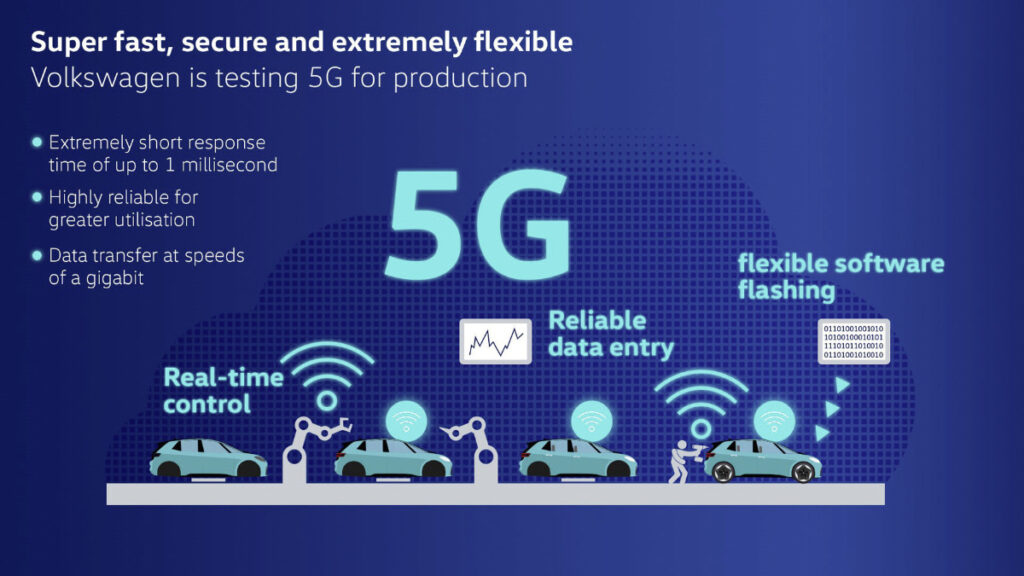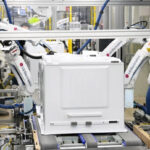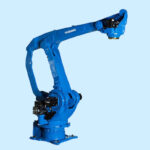ASIA ELECTRONICS INDUSTRYYOUR WINDOW TO SMART MANUFACTURING
Volkswagen Tests 5G to Build Smart Factory Platform
Volkswagen plans to rebuild its car manufacturing factories around 5G technology to make its operation seamlessly networked in what’s called as a smart factory platform.
On the way toward that goal, the European car maker is test-running the smart factory system at its plant in Wolfsburg to see whether the 5G technology can meet the demand requirements of car production
Called as “Campus Network”, a local 5G standalone network is now available at its main plant in Wolfsburg that initially covers the main production development center and the pilot hall.
A dedicated 5G radio frequency will be used to safeguard secure, delay-free transmission of data.
“In implementing our ACCELERATE strategy we are working at full speed to transform our Volkswagen sites into smart factories. Our goal is to continuously optimize our production and make it even more efficient and flexible. We believe that 5G technology has great potential for innovation, from the use of intelligent robots and driverless transportation systems to networked control of plant and machinery in real time up to wireless software flashing of manufactured vehicles,” said Christian Vollmer, Member of the Board of Management of the Volkswagen Brand responsible for Production and Logistics.
Key Technology Enabler
There are already around 5,000 robots at the Volkswagen plant in Wolfsburg, as well as many other machines and systems. Secure, delay-free transmission of data will be required in the future to control and monitor those system.
Latency, -the time it takes for data to be sent through the network – is significantly reduced with 5G networks versus other wireless communication technologies such as WLAN.

5G technology provides extremely short latency times of up to one millisecond, data transmission rates in the gigabit range and considerable reliability even with high utilization. This real-time wireless communication will make many smart factory applications possible for the first time.
One crucial scenario to be tested in the pilot phase under real-life laboratory conditions in Wolfsburg is the wireless upload of data to manufactured vehicles. With ever higher levels of digitization and fully connected vehicles, the production process requires large amounts of data to be transmitted to the cars. 5G makes it possible to perform this much more quickly and at any time during production.
“Efficient wireless communication in real time will be crucial for flexible production in the future. 5G has the potential to be one such driver of the Industrial Internet of Things. Our aim is therefore to build up extensive experience in the operation and industrial use of 5G technology,” said Beate Hofer, CIO of the Volkswagen Group. In the long term, the campus network at the Wolfsburg site is expected to cover large parts of the 6.5 square-kilometer plant site.
Volkswagen is setting up and operating the local 5G infrastructure itself. For the campus network in Wolfsburg, the company applied for and was allocated a private radio frequency at 3.7 to 3.8 GHz with 100 MHz bandwidth by the Federal Network Agency.
5G Becomes Ubiquitous
Exclusive spectrum is a key enabler for 5G campus operations at the manufacturing site. Interference-free, high-availability wireless transmission requires a dedicated frequency that will be used exclusively by Volkswagen for production purposes. The network equipment for the 5G pilot network is supplied by the Finnish telecommunications group Nokia.
The 5G technology is already ubiquitous around many of its car factories. For example, the Transparent Factory in Dresden has also put a so-called “5G island” into operation.
The Dresden factory is a pilot factory for the Volkswagen brand that is testing innovative technologies in normal operation for the pilot-scale ID.3 series
Networked control for a driverless transportation system is being developed further in collaboration with Porsche, Audi and the Dresden University of Technology.
The sensors in the driverless transportation system transmit the environment data to the cloud computer using 5G. This calculates the route to an ID.3 body and sends back the information in real time. The project in Dresden is funded by the German Federal Ministry of Education and Research.




